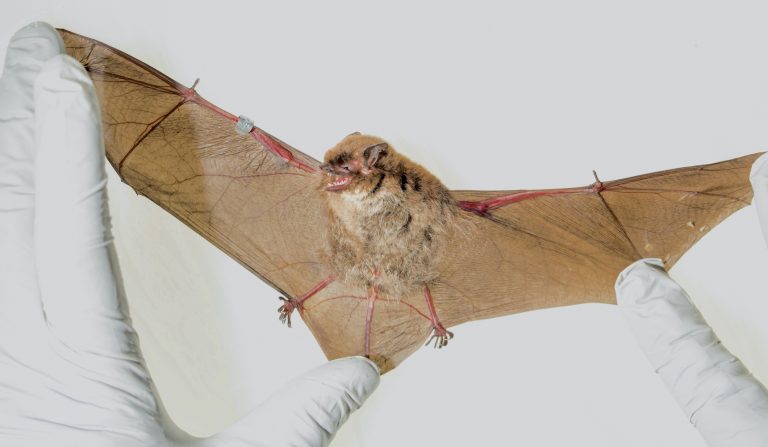What’s this gothic horror doing here and in daylight? The question popped into my head when, decades ago, new to the Subarctic, I returned one July morning to a tatter madly brushing walls in my Fairbanks cabin. Until then, I’d no idea bats survive this far north. The rustling of leathery wings, frankly, gave me belly flutters. Curved needle fangs and the name of Alaska’s most common, most northerly bat, the little brown Myotis lucifugus—“fleeing the light”—play into the whole vampire thing.
My wife, undeterred, finds D. H. Lawrence’s looping “dark-air life,” those black “bits of umbrella,” cute; perhaps the freakiness of a beady-eyed flying shrew or simply the home invasion had me rattled. Conservationists show bat houses to homeowners despairing of garlic braids as a means to deflect topsy-turvy attic tenants wrapped up in themselves and dreaming of—what? Blood banks?
It’s worth recalling that Chiropterans (“Hand Wings”), fielding a fifth of Earth’s 6,000 mammal species, recycle nutrients, enrich soils with guano, and pollinate wildflowers and crops.
Six kinds of bats inhabit Alaska, with little browns far from Texas, their southern limit. True shapeshifters, they adapted admirably to a taxing environment. Long thought to migrate to milder coastal climes, the Interior’s hibernate singly or in clusters in barns, attics, woodpiles, and abandoned cabins, under boulders or bark, or in rock crevices at hot springs. Southeast’s hunker in karst caves, scree fields, and tree-root wads, where crows sometimes spear them. Over 100 have been seen rising from a hollow cottonwood, and at least one has cut curlicues in Kotzebue’s Arctic skies. Winter roosts must be cold enough for metabolisms to slow but warm enough to not turn bats into batsicles. Still, a tenth emerges with raggedy, frost-nipped ears.
Studying bats
Bats caught festooned with cobwebs hint at the secret to their boreal thriving: limited to the dimmest, two-hour slot of high-latitude summer nights, these hunters more than their southern kin snarf orb-weaver spiders, bigger, juicier morsels than moths or mosquitoes. “Endlessly fascinating” to wildlife expert Karen Blejwas, southeastern bats dangling in old-growth snags will sweep logged areas but starve once dense second growth closes the canopy. Luckily, they’re spared huge wind farms and pesticides.

Scientists entrap tumblers the size of rufous-tailed hummingbirds in mist nets strung between trees or held overhead at dusk, concerned that the tangled critters’ twig bones could snap if they leave nylon mesh even briefly untended. They pluck the easily bruised, cinnamon-pelted fruits, slipping several into their warm coats to be processed at a card table when they’ve filled all pockets. To find larger, summer roosts—females, each nursing a naked, blind pup and huddling for warmth—they tag individuals with radio-transmitters or dab on fluorescent-dye dust after measuring, banding, and parasite checks.
Besides rabies, white-nose syndrome plagues bat populations, a fungus boasting 90-percent kill rates and vanquishing normally long-lived millions, spreading flapper-to-flapper. It has reached Washington but not yet surfaced in Alaska. “Since we only know of 10 bat overwintering roosts in the whole state, it’s really hard for us to monitor for white-nose syndrome,” says Tory Rhoads, who oversees a Department of Fish and Game study.
Tracking bats
Researchers like Rhoads, some masked, worried they’ll pass Coronavirus on to their subjects, work hands-in-leather-gloves with citizen biologists the bat bug has bitten. They count heads of launching graveyard shifts owls assail. It’s never rush hour as at Carlsbad Caverns though; Alaskan colonies number between 50 and 470 adults. Volunteers after sunset drive forest-road survey routes aiming ultrasound bat detectors like Geiger counters, for acoustic sampling. Fancy recorders display sonograms and slow shrieks emitted to nail up to 3,000 insects a night and lower their pitch so humans can hear them. Less species-specific than birdcalls, bursts of echolocation signals buzzing and clicking from speakers still reveal distribution ranges and haunts.
The technology for tracking a mouse-eared mystery weighing as little as a quarter is amazing. People who’ve raised VHF antennas from batmobile beds or hiked game cameras and car batteries into the woods for eavesdropping that makes Cold War long-distance spying look like blindman’s buff agree. Regardless, GPS transmitters remain too unwieldy, while radio versions at best last two weeks before falling off. Rhoads thus has deployed a dog trained on fur sniff-patches. It traces bat odors near winter roosts, a non-invasive method also proven at polar bear dens and seal breathing holes.
A broom waved in its Puck face convinced the lost soul in my shack to use the open door. Be gone mantled specter! Wildlife managers recommend catching and releasing grounded strays as you would a wasp: by gentle cupping with a container and sliding in cardboard to seal it, always, always gloved. Feel blessed, if possible, rather than doomed. You’ll as likely meet lucifugus as a lynx or bored bat scientist in these woods.


Comments are closed.